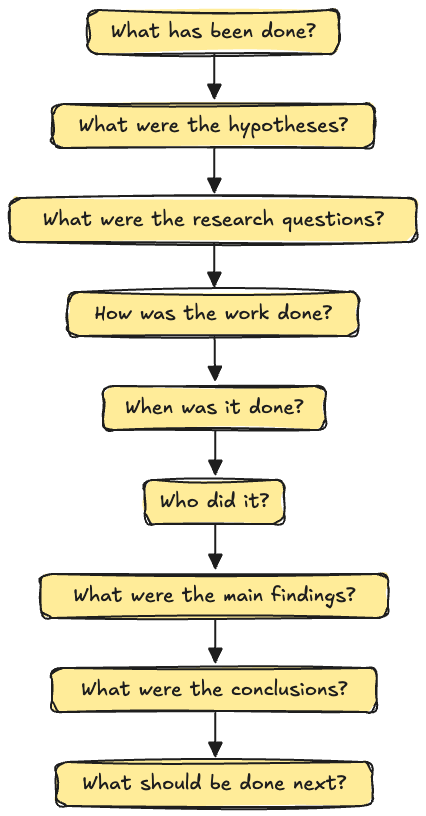Try these 9 lit review questions
My 9-question framework for literature review organization and meaningful contributions
Every researcher faces it: the ocean of information. It demands reading, synthesizing, and turning it into a thorough review. You open papers. Read pages and pages of explanations. Before you know it, you’re knuckles-deep in a fifty-page document. And what do you have to show for it? A series of haphazard summaries that do little more than echo what others have said.
Think of your literature review as the cluttered garage of Tony Stark. Sure, gadgets are everywhere, but without an organizing system, you can’t find your Mark III suit when the world needs saving. Bummer. Enter the 9-question literature review framework. It’s my trusty sidekick. I used it to take a 50-page mess and make it a 10-page juggernaut worthy of Stark Industries. Take that, Nick Fury. You can ask these questions for each paper you review in your literature corpus.
Here’s why it’s different: You must understand the structure rather than getting bogged down in the details. Assessing your literature review is like debugging code. Understanding the system architecture lets you fix individual lines or modules much easier. It’s about asking the right questions to get answers and gets you a map to guide you through the literature. Let me show you how.
1. What has been done?
Let’s start with the simplest question—what’s already been done? This is about surveying the field and mapping out what’s covered. The mission? Draw those lines so clearly even a blindfolded raccoon couldn’t miss them. We need to know which studies form the foundation and which are more like passing trends—flash in the pan. You must distinguish between the two to understand where to focus your efforts for lasting impact. Imagine it’s like preparing a massive Chinese lunch buffet—some dishes are timeless staples, like Ramen (saves you budget, not calories, my friend). In contrast, others are just trendy fusion experiments, like that infamous pickle-flavoured ice cream that might not make it to the table next time. Your task is to figure out which ones deserve a permanent spot in your recipe book.
Start by scanning abstracts of relevant studies. Zero in on the juicy bits—the key areas researchers have already poked and prodded. Identify foundational studies versus more recent, less impactful trends. Grab your pen and start scribbling. Jot down a summary of each major work, focusing on the broad contribution it has made. Consider it your personal mission to decipher the magic that turns these simple words into cultural earthquakes.
Ask:
Which studies are most frequently cited, and why?
Are there any major debates or disagreements in this area?
How has the understanding of this topic evolved over time?
Pro Tip: Scan abstracts to identify the scope of what has already been covered before diving deeper. This saves you time and energy.
2. What were the hypotheses?
Every groundbreaking study kicks off with a spark — a problem begging for a solution. So, let’s cut to the chase: what was this study trying to blow out of the water? When you do this, you start to draw connections between different works — you’re basically cracking the Da Vinci Code. Is everyone investigating the same thing from different angles, or are there conflicting ideas at play? Picture it like a group of Hogwarts students brewing potions: most are making a simple Forgetfulness Potion, but one cheeky student throws in a dash of powdered dragon claw. Are they all aiming for the same potion, or is there an unexpected brain boost in the making? Who doesn’t love a good plot twist?
Go full detective mode. Read the introduction of each study to identify the stated hypothesis. Scan the literature to understand the big questions driving the research in this area, the hypotheses being tested, and whether there are any conflicting ideas or approaches at play. Summarize each hypothesis in one clear, concise sentence. Compare hypotheses across different studies (from the related literature, either in the paper or in your Zotero library) to identify common themes or conflicts. If a paper doesn’t have hypotheses, jump right to the next point and focus on the research questions.
Ask:
What assumptions underlie each hypothesis?
Are there any surprising or unconventional hypotheses?
How do different hypotheses build on or contradict each other?
Pro Tip: Write down each hypothesis in a single sentence (or ask your favourite LLM to simplify the hypothesis from the paper in plain language). This simplicity makes it easy to compare different studies and spot where disagreements arise.
3. What were the research questions?
Hypotheses might be the spine holding it all together, but let’s be real — research questions are the brawny muscles flexing the whole operation. Without them, your paper is just a skeleton in a lab coat! These questions shape the study and determine where the researchers will focus. Let’s say you’re building a treehouse. The hypotheses are your vision and design, but the research questions are where you need to roll up your sleeves and get to work — do you need to reinforce the base, check for rotten wood, or figure out the perfect leaf-proof roof?
Dive into the introductions and methods sections to uncover the specific research questions driving each study. Catalogue every last one, then play connect-the-dots with the similarities, spot the oddballs, and target those glaring gaps. Where are researchers focusing their efforts, and where are the white spaces waiting to be filled?
Ask:
Are the research questions specific or broad?
How do the research questions align with the stated hypothesis?
Do the questions push the boundaries of current understanding, or are they more confirmatory?
Pro Tip: Create a table to list out the research questions from each key study, making it easy to spot patterns, gaps, and conflicts.
Here is the full 4-page 9-Question Literature Review Checklist as a PDF download:




